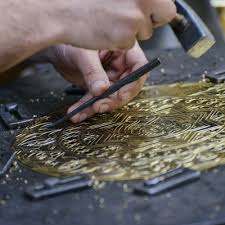The Art of Engraving: Precision and Permanence
Engraving is a time-honored craft that combines precision, artistry, and permanence. Dating back to ancient civilizations, engraving has been used to create intricate designs on various materials, from metal and wood to glass and stone.
One of the defining characteristics of engraving is its permanence. Unlike other forms of decoration that can fade or wear off over time, engravings are etched into the material itself, ensuring that the design will last for generations to come.
Engraving requires a steady hand, attention to detail, and a deep understanding of the material being worked on. Whether done by hand or with modern laser technology, the process involves carefully removing material to create a design with depth and texture.
Engraving is not just about creating beautiful designs; it also serves practical purposes. Engravings are used for personalizing items such as jewelry, trophies, and gifts, adding a unique touch that sets them apart from mass-produced items.
In industrial settings, engraving plays a crucial role in marking products with serial numbers, logos, or other identifying information. This not only adds a professional finish to the product but also helps with traceability and quality control.
As technology has advanced, so too has the art of engraving. Modern laser engraving machines offer unparalleled precision and versatility, allowing for complex designs to be etched with incredible accuracy. This technology has opened up new possibilities for artists, designers, and manufacturers alike.
Whether creating intricate patterns on jewelry or adding branding to industrial components, engraving continues to be a versatile and enduring art form. Its ability to combine beauty with functionality makes it a timeless craft that will continue to captivate us for years to come.
6 Essential Tips for Mastering the Art of Engraving: Tools, Techniques, and Best Practices
- Choose the right engraving tool for the material
- Practice on a scrap piece before engraving the final item
- Use light and consistent pressure for better control
- Clean the surface before engraving to ensure clarity
- Consider the font style and size for readability
- Take breaks to avoid hand fatigue during long engraving sessions
Choose the right engraving tool for the material
When it comes to engraving, selecting the appropriate engraving tool for the material is paramount. Different materials require specific tools to achieve optimal results. For example, a diamond-tipped engraving tool may be ideal for hard surfaces like metal or glass, while a carbide-tipped tool might be better suited for softer materials such as wood or plastic. By choosing the right engraving tool for the job, you can ensure precision and clarity in your designs, resulting in professional-looking engravings that stand the test of time.
Practice on a scrap piece before engraving the final item
Before engraving the final item, it is highly recommended to practice on a scrap piece first. This crucial tip allows engravers to familiarize themselves with the engraving process, test different settings, and ensure that the design turns out as intended. By practicing on a scrap piece, engravers can refine their technique, troubleshoot any issues, and gain confidence before moving on to the actual item. This simple yet effective practice can help prevent costly mistakes and ensure a successful engraving outcome.
Use light and consistent pressure for better control
When engraving, it is crucial to employ light and consistent pressure to achieve better control over the process. By applying gentle pressure consistently, you can ensure a smooth and precise engraving outcome. This technique allows for greater accuracy in creating intricate designs and helps prevent any unintended errors that may arise from uneven pressure. Mastering the art of using light and consistent pressure can elevate the quality of your engravings, resulting in professional-looking and visually appealing finished products.
Clean the surface before engraving to ensure clarity
Cleaning the surface before engraving is a crucial step to ensure clarity and precision in the final result. By removing any dirt, dust, or debris from the material, you create a smooth canvas for the engraving process. This not only enhances the visibility of the design but also helps prevent any imperfections or inconsistencies that may arise from engraving over a dirty surface. Taking the time to clean the surface thoroughly before engraving is a simple yet effective way to achieve professional-looking results that truly stand out.
Consider the font style and size for readability
When engraving, it is essential to carefully consider the font style and size to ensure optimal readability. Choosing a font that is clear and easy to read is crucial, especially when working with intricate designs or small surfaces. The size of the font should also be taken into account to ensure that the text remains legible, whether it’s for decorative purposes or for practical information such as serial numbers or identification marks. By selecting the right font style and size, you can enhance the overall quality and impact of your engraving work, making sure that your message or design is effectively communicated to its intended audience.
Take breaks to avoid hand fatigue during long engraving sessions
Taking breaks during long engraving sessions is essential to prevent hand fatigue and maintain precision in your work. Engraving requires fine motor skills and a steady hand, and prolonged periods of engraving without breaks can lead to strain and decreased accuracy. By incorporating short breaks into your engraving routine, you give your hands a chance to rest and rejuvenate, allowing you to return to your work with renewed focus and dexterity. Remember, caring for your physical well-being is just as important as perfecting your craft in the art of engraving.

No Responses